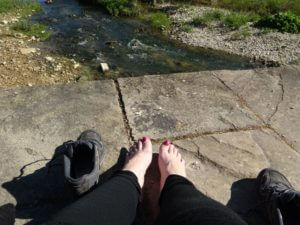1. Choose the right shoes & wear them in
“The most important thing you can do is buy a pair of shoes now and start wearing them in. Walk for an hour a day, then have a glass of wine – that’s the Spanish way!”.
This was great advice from my friend, Shelly, who had completed the Camino a few years prior to me.

The first pair of shoes I bought – 1 size too big – gave me a blood blister on a 5km training walk. My second pair were Salomon hiking shoes (similar to these, but less high tech). About halfway through my 500km Camino, I discovered there wasn’t enough arch support (perhaps I had worn the support down) and bought silicon inserts. Further along the path, I needed even more support (you’ll have to read the blog to find out) 😉
At the end of each day you will feel like slipping into something lightweight, comfy and supportive that allows your feet to breathe. I’ve conquered a lot of miles in my Merrill sandals. If you’re planning on staying in albergues (dormitories) and sharing showers, I also suggest thongs/flip-flops.
Why 2 sizes too big?
Your feet will often swell when you walk long distances so buy them a little bigger than your normal size and pad them with good quality socks. If you tie them firmly across the top of your feet, your feet won’t slip around and your toes won’t get squished when you walk downhill. My big shoes were perfect and I never had a blister with them on the Camino.
To train or not to train?
Of course you should train (but if you haven’t had a chance, don’t let it stop you – keep reading!).
Start on small walks if you need to and build up to regular 5-6km walks and the odd long distance walk of 10-15km. Choosing routes with hills will help. Note that injuries occur on the Camino when you walk too fast so why not slow down and enjoy your training? None of it’s a race.
One of my favourite couples on the Camino had been professional sportspeople in Germany, before moving to New Zealand. They were super fit but had to hobble some parts of the Camino because they had walked too fast in the beginning. They weren’t expecting problems because their bodies were used to moving at a fast pace and they had the fitness to bounce up and down the mountains at home. Fast + Camino does not necessarily equal Happiness.
If you’re going to be travelling with your pack (which I am happy that I chose not to), carry a pack on your training adventures too.
So, you haven’t had time to train?
Don’t let it stop you! Unless you have health issues, in which case please go to your doctor for a checkup. Discuss your walking plans with them.
If your health is good, but your fitness is not, don’t worry – you will get fit on the path!
However, trying to conquer the Pyrenees on your first day if you’re unfit would be an absolute nightmare, so seriously consider where your starting point will be. Plan to walk shorter days for the first week and gradually build as your fitness builds.
As for training, I didn’t do much. A few 5km walks here and there, but as I had a fresh blood blister on my toe (from the shoes which were only one size too big) I wasn’t very keen. “Walk over to my place and we’ll go for a big walk” my friend Irene would say, but by the time I got to her house a few kilometres away we’d just end up walking down the road to the pub. Sounds like the Spanish way!
I’ll be the first to admit that the first week of walking was the hardest (even though the hills weren’t the hugest), due to my level of fitness, but it was still bloody awesome! If I were to choose my favourite section to walk, my first week would be it.
